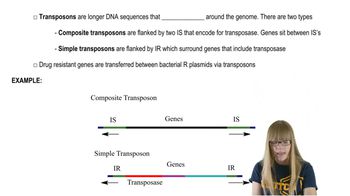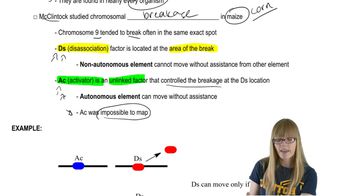Table of contents
- 1. Introduction to Genetics51m
- 2. Mendel's Laws of Inheritance3h 37m
- 3. Extensions to Mendelian Inheritance2h 41m
- 4. Genetic Mapping and Linkage2h 28m
- 5. Genetics of Bacteria and Viruses1h 21m
- 6. Chromosomal Variation1h 48m
- 7. DNA and Chromosome Structure56m
- 8. DNA Replication1h 10m
- 9. Mitosis and Meiosis1h 34m
- 10. Transcription1h 0m
- 11. Translation58m
- 12. Gene Regulation in Prokaryotes1h 19m
- 13. Gene Regulation in Eukaryotes44m
- 14. Genetic Control of Development44m
- 15. Genomes and Genomics1h 50m
- 16. Transposable Elements47m
- 17. Mutation, Repair, and Recombination1h 6m
- 18. Molecular Genetic Tools19m
- 19. Cancer Genetics29m
- 20. Quantitative Genetics1h 26m
- 21. Population Genetics50m
- 22. Evolutionary Genetics29m
16. Transposable Elements
Discovery of Transposable Elements
Problem 18a
Textbook Question
In enhancer trapping experiments, a minimal promoter and a reporter gene are placed adjacent to the end of a transposon so that genomic enhancers adjacent to the insertion site can act to drive expression of the reporter gene. In a modification of this approach, a series of enhancers and a promoter can be placed at the end of a transposon so that transcription is activated from the transposon into adjacent genomic DNA. What types of mutations do you expect to be induced by such a transposon in a mutagenesis experiment?
 Verified step by step guidance
Verified step by step guidance1
Understand the concept of enhancer trapping: Enhancer trapping is a technique used to identify and study enhancers in the genome. It involves inserting a transposon with a minimal promoter and a reporter gene into the genome, allowing nearby enhancers to drive the expression of the reporter gene.
Consider the modification described: In this modified approach, a series of enhancers and a promoter are placed at the end of a transposon, which can activate transcription into adjacent genomic DNA.
Identify potential mutations: The insertion of the transposon can disrupt normal gene function by inserting into coding regions, regulatory regions, or other functional genomic elements, potentially leading to loss-of-function or gain-of-function mutations.
Consider transcriptional activation effects: The enhancers and promoter on the transposon can activate transcription of nearby genes, potentially leading to overexpression or ectopic expression, which can result in gain-of-function mutations.
Evaluate the impact on gene regulation: The insertion of the transposon can alter the regulatory landscape of the genome, affecting the expression of genes near the insertion site and potentially leading to complex phenotypic changes.
Recommended similar problem, with video answer:
 Verified Solution
Verified SolutionThis video solution was recommended by our tutors as helpful for the problem above
Video duration:
2mPlay a video:
Was this helpful?
Key Concepts
Here are the essential concepts you must grasp in order to answer the question correctly.
Transposons
Transposons, or 'jumping genes,' are DNA sequences that can change their position within the genome. They can cause mutations by inserting themselves into or near genes, potentially disrupting normal gene function or regulatory elements. Understanding transposons is crucial for predicting the types of mutations they may induce during experiments, such as enhancer trapping.
Recommended video:
Guided course

Prokaryotic Transposable Elements
Enhancer Elements
Enhancers are regulatory DNA sequences that can increase the likelihood of transcription of specific genes. They can function over long distances and are often located upstream or downstream of the genes they regulate. In the context of transposon experiments, enhancers can activate the expression of a reporter gene, leading to various mutations depending on their interaction with nearby genes.
Recommended video:
Guided course

Drosophila P Element
Mutagenesis
Mutagenesis refers to the process by which genetic information is changed, resulting in mutations. In the context of transposon-induced mutagenesis, the insertion of a transposon can lead to various types of mutations, including insertions, deletions, and point mutations. Understanding mutagenesis is essential for predicting the outcomes of experiments that utilize transposons to manipulate gene expression.
Recommended video:
Guided course

Induced Mutations
Related Videos
Related Practice




